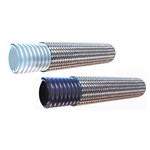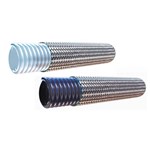Parker 939B-8 Stat-Diss Conv PTFE Hose
Item #:
939B-8
Product Info
Parker Hannifin
The Parker 939/939B series convoluted PTFE hoses feature superior flexibility and kink resistance for successful operation in chemical transfer, high temperature hydraulics, and hose applications that require tight routings. In addition, the flexible capabilities of the hose allow for an improved bend radius than a 919/919B hose for simplified routing and installation. This hose series is offered with a natural, FDA compliant core tube (939) or with a static dissipative core tube (939B) for applications where electrostatic charges could occur during media transfer.Both are reinforced with a 304 Stainless Steel braid for a durable, flexible, kink-resistant solution in numerous fluid handling, transportation and military market applications.
Features:
Applications:
Certifications/Compliance:
Technical Specifications:
Markets:
Fluid Handling|Transportation|Military|IndustrialItem Specifications
-
93N Series
-
4
-
-8
-
Static Dissipative PTFE
-
1/2 Inch (13 MM)
-
0.79 Inch (20.1 MM)
-
Stainless Steel
-
Static-Dissipative PTFE, Static Dissipative
-
1350 psi (93 Bar, 9.3 MPa)
-
450 °F
-
Air, Chemicals, Hydraulic Fluid, Oil, Water
-
2 7/8 Inch (73 MM)
-
-100 °F
-
Hose Products
-
Fluid Connector
-
28 inHG (711.2 MM-Hg)
-
0.17 lbs per




